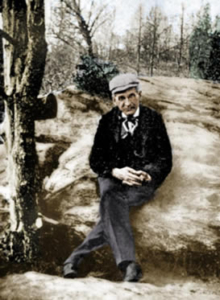William W. Bailey
February 22, 1843—February 20, 1914
2009 Rhode Island Distinguished Naturalist
William Whitman Bailey was born in West Point, NY in 1843 to Jacob Whitman Bailey and his wife, Maria Slaughter. His father was a professor of Chemistry at West Point. He had three siblings, Maria Whitman, Samuel Slaughter, and Loring Woart. Whitman was his paternal grandmother’s maiden name.
William Bailey had a childhood disrupted repeatedly by personal tragedy.
 In 1849, when he was 6, his father, Jacob, suffered a throat hemorrhage and, leaving his family, traveled to the southern United Sates for seven months in hopes of improving his heath. He returns being able to speak, but not lecture.
In 1849, when he was 6, his father, Jacob, suffered a throat hemorrhage and, leaving his family, traveled to the southern United Sates for seven months in hopes of improving his heath. He returns being able to speak, but not lecture.
William lost his mother and sister in a horrific ship disaster when he was 9. In 1852, his family decided to take a trip to the shore in hopes of improving the health of his older sister. They chose to travel on the 198 foot side-wheeler, Henry Clay. On this day the ship became involved in a race with another steam boat, the Armenia, that ended in a minor collision with apparently little damage to the Henry Clay. The Henry Clay continued on route to New York and about an hour from its destination was found to be burning amidship. It managed to turn and violently ground itself on shore near Yonkers going 25 feet up a railroad embankment. Passengers who were on the bow of the ship were either thrown to the ground or able to drop onto land. However, people at the back of the boat were 140 feet from shore and blocked by the fire. The Baileys jumped into the water when the fire approached. William grabbed hold of a wicker chair and was picked up by another boat. His father kept his wife and daughter afloat until he was able to bring them along side the ship where they could grasp some ropes that were hanging from the ship. At this point, Jacob is pulled under the water by a drowning woman. When he finally resurfaces, his wife and daughter are gone and the boat an inferno. He is pulled to shore not knowing his son has survived and refuses to believe it is so until he is reunited with William.
The experience left William with permanent health problems. “After the dread event and consequent shock I never regained my original tone.” he would write at a later date.
And his father never recovers from the death of his wife and daughter. Jacob sends his older boys away to school and tries to make a home for William, but his health deteriorates and he dies in 1857.
William is fourteen and leaves his family home to live with his uncle in Providence, RI.
Three years later at the age of 17, he loses his oldest brother, Samuel. William and his brother, Loring, are the only remaining members of the family.
In 1860, he attends Brown University, but leaves the University with out a degree. In 1862, he enlists in the Tenth Regiment Rhode Island Volunteers, but is discharged for health reasons.
He works for a while as an industrial chemist, but becomes a student of Dr. Asa Gray at Harvard and becomes interested in botany. With Asa Gray’s help, he becomes the botanist for the United States Geological Exploration of the 40th parallel in 1867. Unfortunately, his indifferent health deteriorates and forces him to leave the expedition.
Bailey worked at several private schools, did herbarium work at Columbia College with Dr. John Torrey, and studied and taught summer classes at Harvard. Bailey eventually returns to Brown University and, in 1877, starts a private class in botany which is the first botany class taught at Brown. It becomes part of the curriculum and he is made a professor.
With a secure income, he is finally able to wed Eliza Randall Simmons in 1881. They have a daughter Margaret Emerson (1885 – 1949) and a son Whitman (1884 – 1954). Margaret became an author in her own right and, although color-blind, Whitman became a successful artist known especially for his black and white sketches.
 In 1880, Bailey wrote his “Botanical Collector’s Handbook” published in 1881. This was followed by Botanical Note-Book (1894-1897), “New England Wild Flowers and their Seasons” (1895), Botanizing (1899) and, the inspiration for this website, “Among Rhode Island Wild Flowers” (1895). He also wrote a number of articles for various botanical publications.
In 1880, Bailey wrote his “Botanical Collector’s Handbook” published in 1881. This was followed by Botanical Note-Book (1894-1897), “New England Wild Flowers and their Seasons” (1895), Botanizing (1899) and, the inspiration for this website, “Among Rhode Island Wild Flowers” (1895). He also wrote a number of articles for various botanical publications.
Bailey died in 1914.
2009 Distinguished Naturalist
William Whitman Bailey was a scientist with an interest in several disciplines, a field trip leader, a poet, a writer, a soldier, an artist, but most of all he was a naturalist who can convey his passionate sense of wonder, joy and reverence of the natural world to others even past his death and across decades.
He loved the camaraderie of kindred spirits and the stimulation of conversation with other members of the local scientific community such as James Bennett, George Hunt, and Howard Preston. In “Among RI Wild flowers” he wrote of a “pretty meadow” in Cumberland,
“In one of these there is a spring, over which a large witch-hazel hangs out, in autumn, its weird, yellow blossoms. It is our habit to lunch at this spot. The impulse is upon us to tell of these joyous wayside repasts; the pleasant chats; the quips; the jokes; the laughter and song.”
He makes it quite clear that the companionship added to his trips of exploration. It wasn’t enough to have the knowledge, the interest and excitement of a rare botanical find or a new concept, it had to be shared with others.
This website, Among Rhode Island Wildflowers, is dedicated to the proposition that Professor Bailey was right and that scientific knowledge should be recorded and shared and that it can be done with quips, laughter and pleasant chats.
And, one last image of Will Bailey. In an autobiographical account of her childhood, his daughter Margaret Emerson Bailey wrote this about her father;
“Ever since I can remember, everybody’s felt they could come to you with questions. I can’t remember any walk we ever took when someone didn’t stop you on the street and want to know about a plant of some sort. I never knew you once to make them feel ridiculous, even when you had to say that what they asked about was just a common dandelion. No matter what it was, you treated ignorance with dignity.”
And this is why William Whitman Bailey has been chosen as a RI Natural History Survey’s Rhode Island Distinguished Naturalist. Not just because of his scientific knowledge and academic achievements, but because of his ability to reach out to others and share his warmth, his knowledge and his passion for the natural world.
